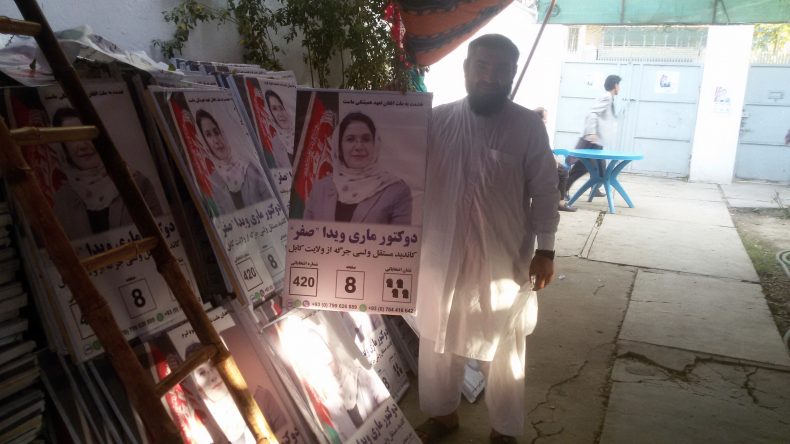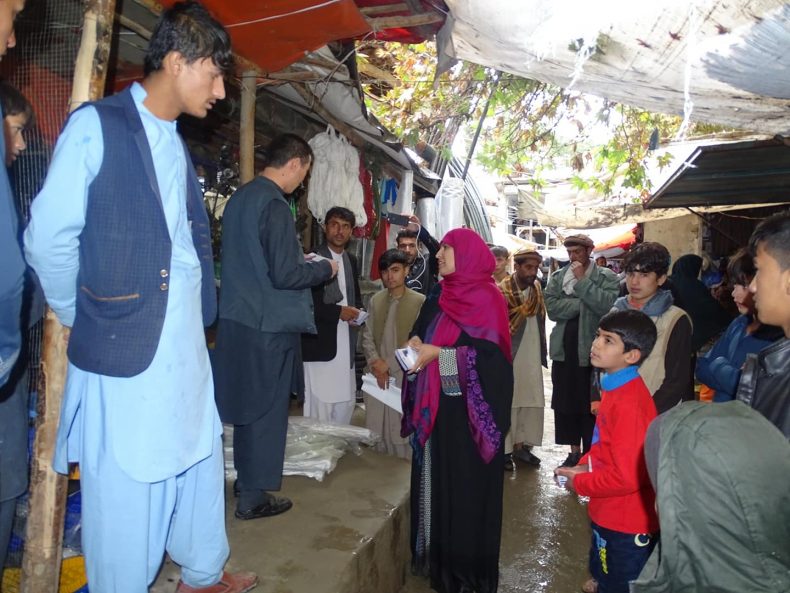Afghanistan is holding its parliamentary elections on October 20, 2018 after a three-and-half-year delay due to voter fraud and security concerns. To date, a total of 10 candidates have been killed during the ramp up to elections, with the last killed the last night of the official campaigning period, October 17.
“What makes this election different, is it is bloodier and more violent than the previous ones,” said Horia Mosadiq, an Afghan expert in safety and security trainings. “This violence is coming from the Taliban and political opponents.”
The elections were supposed to run in 2015, also a bloody year. On a hot summer day in 2015, Homera Kohzad, then working as an adviser to the governor of Baghlan, was leading an event to break the fast for Ramadan at a mosque. During the iftar a suicide bomber attacked, injuring 41 people, including Kohzad, who was critically injured.
“If a woman is not safe in a mosque, where can she be safe?” said Kohzad from her home in Kabul, just one week before the kick off of her parliamentary campaign in Baghlan. Kohzad shared photos with The Diplomat of her recovery in the hospital, showing numerous shrapnel scars on her legs. “It took me 21 days to recover, to be able to walk. My complete healing time was three months.”
With an electronic voter registration system in place since the spring, about 2,500 candidates went through the nomination process for the lower Wolesi Jirga. Of those, 418 are women, representing just 17 percent of the candidates – despite a quota set at 27 percent out of 249 total seats for women, or 68 seats.
While this system is designed to encourage a democratic vote, it has been used by Afghanistan’s patronage system, which has powerful backers, such as warlords, drug lords, and Afghanistan’s mafia, according to research by AREU.
“The electoral law creates enormous obstacles in the way of candidates, starting from requiring a financial deposit all the way to furnishing the stamped tazkiras [national identification numbers] of at least 1,000 unique supporters,” says Ahmad Shuja, an independent Afghan researcher. “These hurdles affect female candidates disproportionately because it is often harder for them to mobilize financial assets and to work clan or tribal networks to raise the requisite number of tazkiras.”
Shuja observes that deteriorating security especially impacts women. “Women’s public participation is more noticeable and therefore attracts more unwanted attention.”
A Snapshot of Two Women Candidates
In Baghlan province, Kohzad is registered as an independent, candidate number 40, competing against 88 candidates for eight seats. Baghlan province has just about 800,000 people, with 80 percent of the population living in rural areas and 20 percent living in urban locales. Kohzad campaigned in the villages, where phone and electricity coverage is poor. She says there is a lack of access to sanitary facilities for women, which made her campaign work difficult. And it’s a traditional province, which has been becoming increasingly insecure.
Kohzad said she was the first female adviser from her district to work with the governor of Baghlan and believes she was targeted in 2015 because of this. “The National Directorate of Security (NDS) said it happened because I was a woman and because of the position I was carrying. The attackers knew I was running for the upcoming election.”
In contrast, Kabul province is less remote with better amenities. The province has a population of about 4 million, with 83.5 percent living in urban areas and 16.5 percent in rural areas, according to the World Bank. In Kabul, there are 800 candidates running for 33 seats, with nine reserved for women through the quota system.
One such candidate, Dr. Mary Wida Safar, is a general surgeon running for Kabul province. Like Kohzad, Wida is a pioneer in her profession. She said she was one of the first general female surgeon in Kabul, as most female doctors focus on women’s health (gynecology), to avoid the stigma and safety concerns connected with sexual harassment.
Wida seems undeterred by this. After working 12 years in a government hospital by day and in her own private clinic by night, she now focused on running her own clinic. She also drives her own car. As a Kabul-based independent candidate, she is candidate number 420, a number that Afghans believe signals “clever.”
While she has a host of volunteer supporters who distribute her campaign materials, she said that she has been approached by people asking to be paid to vote for her.
“Sometimes people come to the campaign office and ask for money to support me as they say other candidates offer this. But I will say that I am representing people by choice,” said Wida. Her main campaign materials are billboards, signboards, brochures, flyers, social media, and signs on cars. “I have also been on radio and TV shows.”
Their Platforms
Wida says she is running for parliament to tackle health and human rights policy concerns that other parliament members do not have the capacity to address. Wida, like Kohzad, believes that many parliament members come to their post through powerful backers and are not professionally equipped to support important sectors, such as the health sector.
“We have an association of doctors, but it is useless, and no one works for this. We have problems of kidnapping doctors and violence against doctors,” Wida said. “There was a cardiologist from Ibn -i -Sina hospital who was abducted by gunmen in March of this year.” Hospitals have been bombed and international organizations have pulled out due to their staff being killed. According to World Health Organization statistics, there are 0.3 doctors to every 1,000 persons in Afghanistan.
In Afghanistan, patients die from otherwise treatable illnesses. For instance, Wida says that patients with hepatitis and who are HIV positive will be turned away, in some cases to die. She recently operated on a patient with hepatitis who had appendicitis. While other hospitals turn away such patients, Wida says these patients can be treated with protective, disposable gowns and equipment.
General surgeon Ahmad Naweed Hamkar, who works at a government hospital in Kabul, says only two hospitals in Kabul will operate on patients with hepatitis and who are HIV positive due to a lack of facilities. While disposable protective material is available, the vast majority of government hospitals don’t have access.
In addition, Afghanistan’s limited pharmaceutical regulatory system must contend with counterfeit medicines.
“We have pharmaceutical companies in Afghanistan that need regulating, while the imports we get from Pakistan are the lowest quality. We should fight the companies engaged in illegal imports and help the local pharmaceuticals that are Afghan-founded,” said Wida.
Afghans use opiates to treat pain, which often leads to addiction. With a lack of public health education, husbands give opiates to wives, who in turn give it to their children, key issues Wida would like to address as a lawmaker.
Meanwhile, Kohzad said that she would like to advocate on behalf of her province for Afghanistan’s youth. The opportunities for education in Baghlan are very limited compared to the urban hubs like Kabul. Top universities, such as the American University of Afghanistan, are not in Baghlan – and many youth migrate due to the lack of opportunities.
Kohzad would like to develop Baghlan’s private sector to bring more work more options to her constituency. After surviving the suicide attack, she moved to Kabul and helped establish the popular Bost restaurant in 2016, which is a women-led restaurant, designed as a safe space for women and families. She is also an advisory board member of the Afghan Women’s Chamber of Commerce and Industry (AWCCI). Kohzad believes that the current parliament, pressured by powerful warlord interests, lacks the capacity to bring change to her province and that experience and skills are needed to bring reform.
Zia Wahaj, an Afghan researcher who conducted research on market safety across 10 provinces, including Baghlan and Kabul, said that for women working in the private sector, “it is daunting to operate a business in a context largely dominated by sociocultural conservativeness, [with] poor access to affordable credit and skilled workers.”
Peace is also a key issue for Kohzad, who wants to honor her father’s legacy. In 2017, her father, Assadullah Kohzad, a well-known activist, civil society, and political party leader, was assassinated by unknown gunmen in front of his home.
“[Our opponents] want to put a lock on this – we belonged to influential family – serving people was always our priority,” said Kohzad.
“My father was raising the concern – why is security not being addressed by the government? From both sides, our children are getting killed – the Taliban and our side [the government], both sides have mothers. We are losing from both sides.”
The Security Question
Personal security is an issue for both male and female candidates and political activists, according to security training expert Horia Mosadiq. However, “[women] are not able to get the same level of protection, such as body guards, armored vehicles, and escorts to rural areas. Also, culturally men are able to get favors and support that women cannot get.”
But safety is something that women can train for. “In Afghanistan, not many women are digitally aware. It is easy for intruders to hack into their accounts – to use their information, photos, and private details.”
In rural areas, where education is more limited, it’s easier manipulate public opinion by posting false or private information. Photos of women not wearing a headscarf, or drinking, shaking hands, hugging men – “it automatically compromises their safety and chances to win,” said Mosadiq.
“Fake Facebook accounts are being made and hackers will have the fake account insult Afghan religion, which puts the women’s lives at risk.”
Mosadiq notes attackers can be insurgents or even opponents who don’t want to lose the vote to a more popular candidate.
After Kohzad’s father’s death, the family, in their search for answers, asked the Taliban. Their spokesperson said the father was not a target “because peace is not something we don’t want,” Kohzad said. Instead, the Taliban blamed foreigners “who don’t see the benefits of peace.”
For Kohzad, this time around, the risk seems to be worth it. In one video clip posted to social media during her campaign, a market seller in a remote village told Kohzad that he will vote for her because women work for the people, unlike men who work for themselves. “We are very happy when women win the election,” the seller said.
Michelle Tolson is a freelance journalist based in Asia.



































